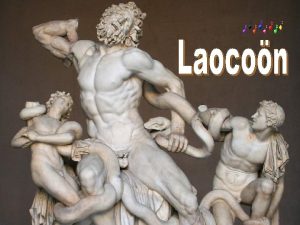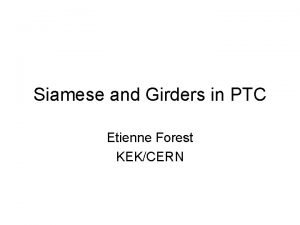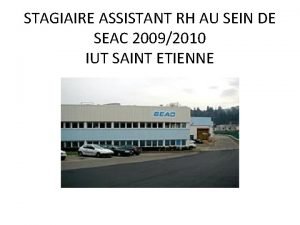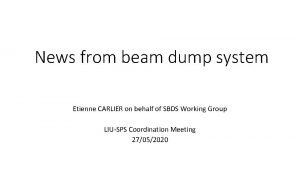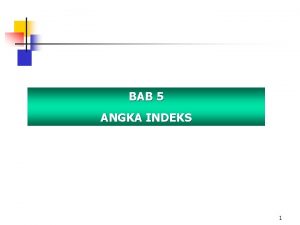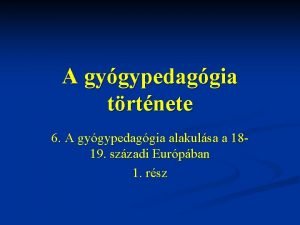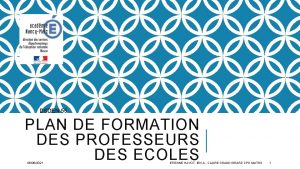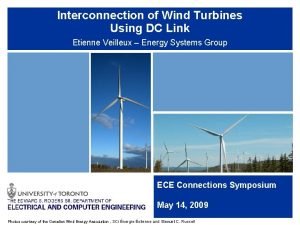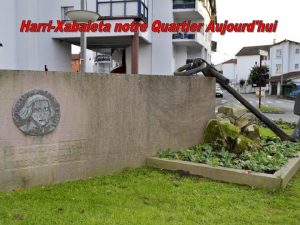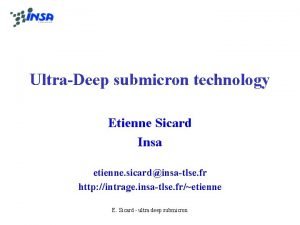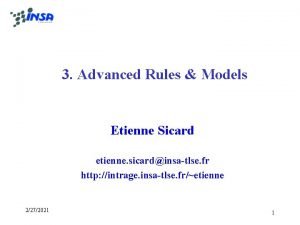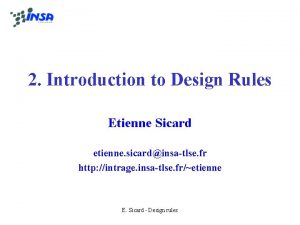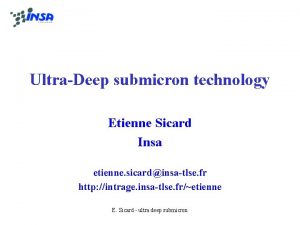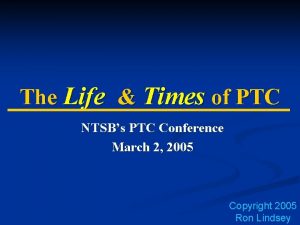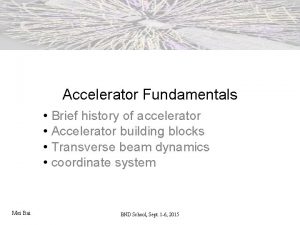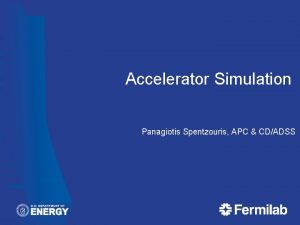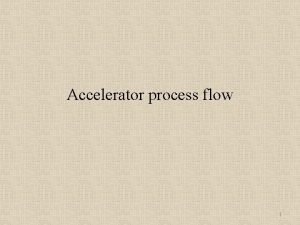Accelerator Modeling with PTC What is PTC Etienne

















- Slides: 17

Accelerator Modeling with PTC What is PTC? Etienne Forest 高エネルギー加速器研究機構 (KEK)

Why talking about PTC? • Epsilon documentation, no support and no patience. • I suppose because it is in MAD-X • MAD is a code from CERN • Code was written by order of the present MAD-X guru Frank Schmidt • Code contains vaguely interesting ideas especially in the light of the CLASSIC collapse (MAD 9)

What is PTC? • Contains two parts 1. FPP => Overloading of Berz and Forest FORTRAN 77 tools for production and analysis of Taylor Maps. Creation of a convenient Polymorphic Taylor Type. 2. PTC proper=> A single particle tracking code with structures fully exploiting the “s”-maps of magnets which also uses FPP.

FPP • Stands for fully polymorphic package. It is only useful if you know what to do with a Taylor map. • Personally I use it mainly for lattice function calculations and other perturbative calculations. • Nothing new there if you know my work.

Example in a Tracking Environment SUBROUTINE EXAMPLE_TWISS USE ORBIT_PTC IMPLICIT NONE INTEGER I, NO REAL(DP) BETA_X TYPE(REAL_8) X_POL(6) TYPE(DAMAP) ID TYPE(NORMALFORM) NFORM CALL ALLOC(X_POL); DO I=1, MY_ORBIT_LATTICE%ORBIT_N_NODE CALL ORBIT_TRACK_NODE(I, X_POL) ENDDO WRITE(6, *) "POLYMORPHS PRINTED " CALL PRINT(X_POL, 6) ! WE WILL DO A TWISS CALCULATION OF BETA_X IF(NO>0) THEN NFORM=X_POL WRITE(6, *) NFORM%TUNE X_ORBIT=0. D 0; X_ORBIT(5)=0. 01 D 0; CALL FIND_ORBIT(MY_RING, X_ORBIT, 1) X_POL=X_ORBIT+NFORM%A_T BETA_X= (X_POL(1). SUB. '10')**2+(X_POL(1). SUB. '01')**2 WRITE(6, *) X_ORBIT WRITE(6, *) & "GIVE ORDER OF TAYLOR MAP "; READ(5, *) NO; IF(NO>0) THEN CALL INIT(NO) CALL ALLOC(ID); CALL ALLOC(NFORM); ID=1 X_POL=X_ORBIT+ID ELSE X_POL=X_ORBIT ENDIF WRITE(6, *) 'POS = ', 0, ' BETA_X = ', BETA_X DO I=1, MY_ORBIT_LATTICE%ORBIT_N_NODE CALL ORBIT_TRACK_NODE(I, X_POL, DEFAULT) BETA_X= (X_POL(1). SUB. '10')**2+(X_POL(1). SUB. '01')**2 IF(MOD(I, 50)==1. OR. I==MY_ORBIT_LATTICE%ORBIT_N_NODE) & WRITE(6, *) 'POS = ', I, ' BETA_X = ', BETA_X ENDDO ENDIF CALL KILL(X_POL); IF(NO>1) THEN CALL KILL(ID); ENDIF END SUBROUTINE EXAMPLE_TWISS

More about FPP? • Please come to the poster session! • Or bug me any time during this conference! • Conclusion: FPP overloads Berz’s Old package in FORTRAN 90 and my own Lie/Da/etc. . analysis tools (Lielib) from the old days. • An essential but independent part of PTC and PTC based software such as MAD-XP.

What is structurally new in What PTC? is new in PTC?

Things which are not really new! • Its is an “exact” integrator: So is TEAPOT, so is Meot’s code Zgoubi. • It is, for the most part, a symplectic integrator: so are kick codes and TEAPOT. • It is an explicit symplectic integrator which can handle correctly the body of magnets (square-root effect): Well perhaps most complete but this was first a Talman idea. • Using TPSA (Berz’s DA) and Forest’s Lielib in all perturbative calculations: I have been bitching about this since 1986! • Taylor Polymorphism: Berz in interpreted form (COSY) and Bengtsson in compiled form since the late 80 s or early 90 s. • Radiation through beam envelopes rather that the stinky Sands integrals: Oide in SAD in the early 90 s. • Etc…

New Stuff: Motivation • “Real World”: Newton-Lorentz Equation Primordial input Describing the global B field is what matter

Accelerator Code sj+1 sj si si+1

Summary Standard Laws of Physics Arrangement of Hardware → Global B, E → Lorentz → Propagation for a time dt Usual Beam Dynamics Code ? → Generic Magnet → Magnet Propagator → Propagation through the magnet Local B, E Question: what kind of structures should be located above the generic magnet? This question fits in the object oriented paradigm in which MAD 9 swam and ultimately sunk because objected oriented programming is centred around data rather than algorithms.

Magnet Oriented • Obviously map(s) attached to magnets are central objects. • The B/E field is important but it is now attached to a magnet rather than a global object. • The two propagators shown in previous slide can exist in the same machine: dogbone, colliders, etc… • What can we conclude?

Structures 1. Beam lines are actually link lists of the discretized “s” variables and not sequences of magnet propagators as in standard codes. 2. I baptized the element of this sequence “fibres” inspired by Hirata since it is connected to the mathematical fibre bundles. 3. Fibres contains pointers to magnets and pointers to transformations to the local variables used at that particular “s” position: my so-called patches. WHY?

Example: Recirculator Magnify this common region

Pictorial Justification • dafne Dog bone Hose Epsilon documentation, no support and no patience.

My solution

Conclusions • Most bizarre topologies permitted: recirculators, dog bones, colliders and multiple combinations of these horrors • Fully 3 d lattices like the quadrupole fibres of Mori and Machida. In PTC the survey command is essentially useless and definitely arbitrary. It is used for double checking geometric patching or entering standard lattices. (N. B. MAD and SAD have different conventions for survey!) • PTC is only one possible solution: Malitsky has done some work to generalize the ideas in this lecture. In particular we should be able to access diverse propagators from any kind of complex structures.
 Helen c. erickson
Helen c. erickson Dimensional modeling vs relational modeling
Dimensional modeling vs relational modeling Stiftung phönix zug
Stiftung phönix zug Etienne bossut
Etienne bossut Earl etienne dominica
Earl etienne dominica Etienne forest
Etienne forest Etienne kairis
Etienne kairis Etienne kairis
Etienne kairis Dom perignon monk
Dom perignon monk Seac saint etienne
Seac saint etienne Etienne prinsloo
Etienne prinsloo Etienne carlier
Etienne carlier Indeks relatif sederhana
Indeks relatif sederhana Jean-étienne esquirol
Jean-étienne esquirol Dsden 55
Dsden 55 Etienne veilleux
Etienne veilleux Etienne pellot
Etienne pellot Saint etienne ville moche
Saint etienne ville moche



